Water is unquestionably vital to human life. Most of the surface of our planet is made of water — and the majority of the human body is too.
But though this essential, hydrating fluid should be clear, refreshing and healthful, it isn’t always. Pollution, pesticides, other chemicals, heavy metals, and organic waste can all potentially seep into our water supplies. At best, they impart a mildly unpleasant tang or smell to our water. At worst, they compromise our short-term and long-term health.
Fortunately, water filtration and purification systems provide a convenient and cost-effective way to make sure you have clean, refreshing water in your home and even on the go. According to the EPA and the Water Quality Association, 40% of Americans use some form of water filtration in their homes to enhance the quality of their water. Below, we’ll discuss the importance of purifying or filtering drinking water and show you the benefits of doing so.
Why do we use water filters? Filtering your water is important for both aesthetic and health-related reasons. Filtered water helps provide these essential benefits:
Filtered water generally tastes better than unfiltered water. Chlorine, pesticides, bacteria, and heavy metals can all contribute to water that has an unpleasant taste or aftertaste.
Municipal tap water is usually safe to drink. But just because your water will not harm your health does not mean it is of high quality. Safe tap water may still contain contaminants that give your water an unpleasant taste, smell, or cloudy appearance. A water filtration system reduces these contaminants to provide you with clean, great-tasting drinking water.
Chlorine, pesticides, bacteria, and heavy metals also contribute to bad-smelling water. Have you ever been to an old farmhouse in the country where all the water coming out of the taps smelled like pennies? Metals like zinc, iron, and copper can leach into groundwater and lead to rust stains in the bathroom and metallic-smelling water coming out of the taps. Chlorine or Chloramine – which are added to most municipally supplied water to prevent microbiological contamination – both have strong chemical odors that can make the water unpleasant to consume.
Not all contaminants give off a bad smell. But some, like volatile organic compounds (VOCs), which include formaldehyde and ethylene, can give your water a distinctively unpleasant odor. VOCs have been implicated in effects ranging from skin irritation to liver and kidney damage to carcinogenic effects, so if your water smells off, you will undoubtedly want to invest in water filtration. Plus, better-smelling water is just more pleasant for the senses.
Though some people turn to bottled water in an attempt to ensure that their drinking water is contaminant-free, buying cases of bottled water becomes environmentally expensive very quickly. Filling our landfills with plastic bottles is also harmful to the environment, and many areas don’t have the resources or infrastructure to recycle plastic bottles properly. Because the United States can no longer ship as much trash abroad, some cities have turned to throwing away or incinerating the materials that residents put out to be recycled. Using water filtration systems instead of bottled water helps keep nonbiodegradable plastic bottles out of our landfills and incinerators.
Flooding and construction can add all kinds of contaminants to your water supply, especially if your water is well water. Recently, flooding in the Midwest led to a high incidence of well-water contamination, and similar effects are possible no matter where you live. As floodwaters sweep across the landscape, they can pick up chemicals, waste products, and other harmful contaminants and eventually deposit them in human water supplies. Wells and reservoirs that become overtopped by floodwater are at particularly high risk of water contamination, but floodwaters that merely saturate the surrounding soil can also seep into a well if it is older and not adequately sealed.
Construction can also lead to high levels of water contaminants. Construction materials such as chemicals, plastics, and adhesives leach into the soil and from there into the groundwater, where they can have adverse effects on human health if they make it into drinking water without being filtered out. If the construction project is a renovation of an older building, asbestos contamination, in particular, poses a serious risk.

Lead, chlorine, pesticides, viruses, and more — all these contaminants can have serious adverse effects on your health if they make it into your home’s drinking water. Water can also contain microbiological contaminants such as bacteria, giardia and cryptosporidium. A water purifier can help protect against these harmful microorganisms so that you don’t get sick from ingesting these organisms.
Don’t forget about cooking, too. If your water is unsafe to drink, it’s also unsafe to cook with, brush your teeth with or wash vegetables in. Filtering your water also helps protect your health in these often-overlooked areas.
And showering in contaminated water can also make you feel rundown. If your water contains chlorine, inhaling chlorine as you shower can lead to respiratory ailments.
On the other hand, hydrating yourself with clean, clear water leaves you feeling refreshed and energized. The peace of mind you feel from knowing your water is safely filtered — along with the crisp, clean taste of filtered water — will often encourage you to drink more water and feel healthier.
If you have children in your household, remember that their immune systems are still developing. So filtered water is crucial to keeping your children healthy and thriving.
Removal of Contaminants
The right water filtration or purification system can help reduce the concentration of many types of contaminants in your home’s water:
Lead, a neurotoxin, can also seep into groundwater or leak into tapwater from old lead pipes, fittings and fixtures. Even low levels of lead in water can be harmful to human health, especially for young children whose bodies and nervous systems are still developing. The water crisis in Flint, Michigan showed us just how harmful lead-contaminated water can be to a community’s health. Lead in water can cause minor irritations such as itchy skin, rashes, and hair loss. It also causes serious issues such as high blood pressure, kidney disease, cardiovascular disease, and infertility, along with the profound neurological problems it is notorious for causing in children. Filtering your water is an excellent way to help remove lead and protect your family’s health.
Chlorine is often added to tap water for good reason — it kills bacteria that would make us ill if we ingested them. But chlorine is not ideal for us to consume in high doses either. High levels of chlorine in water can lead to infant congenital abnormalities, for instance. Chlorine also has a drying effect, so filtering the chlorine out of your water leaves you with more moisturized, elastic, younger-looking, and younger-feeling skin and fewer skin rashes and irritation. And filtering the chlorine out of your water will also leave you with more hydrated, softer, and shinier hair.
When chlorine interacts with organic matter, it can also lead to the formation of trihalomethanes (THMs), which have been linked to carcinogenic activity. Fortunately, activated carbon filtration is effective in reducing concentrations of THMs.
High concentrations of mineral contaminants in your water can lead to a mineral …

Given that we live in a world where the scope to use resources is limited by climate change, it is important for us to minimize the effects of water purification on the environment. Some of these effects have recently been discussed in a number of events and webinars; however, these have failed to include an overview and to tackle a number of important aspects of the issue.

Potential environmental impacts arise in all areas of pure water delivery: the production, testing and transport of a new water purification system and the entire life-cycle of its use and disposal, including servicing and consumables. Water purification system design and the choice of technologies and components play key roles in limiting the environmental impact of a water treatment system.
The key and largest impacts on the environment are placed by total energy consumption, expressed as carbon footprint, water usage and component composition and disposal/reuse. However, reductions of environmental impacts can be affected by the corporate ethos of the system manufacturer.
Environmental Innovation is at The Heart of What We Do
Veolia is an organisation linked closely with resolving environmental issues and it works to increase employee awareness and involvement. For example, a recent employee-orientated campaign “Together, committed to the environment” has been launched. In practical terms, such initiatives can lead to significant environmental and, in the mid-to-long term, financial savings.
Examples include the use of spin-welding and ultrasonic welding rather than hot-plate welding to seal together the sections of water purification cartridges and the recycling of water used in testing new units. The former has led to significant lower energy usage and also saved time and increased reliability, making further energy savings, while the latter has saved considerable volumes of water without any loss in effectiveness of testing.
Carbon Footprint Calculator
As a holistic approach to ‘environmental impact’, an online carbon footprint calculator has been set up to estimate the carbon footprint for each product (and combination of products) for their full lifetime. It takes into account the estimated water usage, consumables, accessories, product delivery, number of services required as well as an assessment of the transport mode. This approach allows for the comparison of different products and identifies the steps which produce most carbon so that alternative solutions can be considered.
Production and Distribution of Water Purification Systems
In manufacturing and production, the choice and types of component used and their suppliers, and the use of energy-efficient and/or water-efficient techniques all lead to reduced environmental impact directly, and to reduced service call-outs through increased product reliability. In addition, the following factors are also taken into consideration: localized distribution centres, lower carbon sea rather than air transport and reduced product packaging.
Operational Aspects of Water Treatment Systems
The water treatment technologies selected will have a major impact on water and power usage though-out the life of a water purification system. Each consumable will have a carbon footprint and there will also be a footprint for any service visits. Overall the objective is to maximise the lifetime of components and the reliability of the system, hence to minimize service visits. Other operational aspects include the reduction of power usage by 5% per product and reducing the product waste water by 12% per unit.
Reverse Osmosis versus Distillation
The choice of technology to remove the great majority of impurities in the feedwater lies between distillation and reverse osmosis (RO). In environmental (and economic) terms, distillation requires far more energy. For example, producing 1 litre of distilled water typically requires 1.65kW of power and about 9 litres of cooling water; in comparison, producing 1 litre of RO permeate requires less than 0.1 kW and less than 5 litres of water. The waste water from RO is cold and similar to the feed water and could be used in various grey water roles. ELGA uses only reverse osmosis in its water systems due to the energy costs of distillation and its limited purification capabilities.
Optimization of Reverse Osmosis
Optimum operation of RO systems minimizes the frequency of changing subsequent purification consumables, notably the purification packs. For this reason, simply minimizing water rejection in RO can be counter-productive environmentally in the long term.
Dissolved Carbon Dioxide Reduces Water Purification System Life
Dissolved carbon dioxide is a common contaminant of hard feed waters that is not removed by RO. Its presence will seriously reduce purification pack lifetimes. It is effectively reduced to low levels by degassing the RO permeate, with significant benefits environmentally. Degassing also reduces the load on water purifiers using electrodeionization (EDI) systems and enables them to be used effectively with a much wider range of feed-waters. EDI deionizers have a relatively high carbon footprint to manufacture but reduce subsequent cartridge change frequency significantly.
Optimization of Ion-Exchange Maximises Water Treatment System Life
Good design ensures that, as far as possible, each water purification step is run optimally to minimize, for example, the change out of filters and UV lamps. With ion exchange, a twin-bed approach with intermediate resistivity monitoring maximises the use of active media.

Seemingly minor enhancements all accumulate to reduce environment impacts e.g. the use of high purity quartz in the UV chambers prolongs life and increases robustness. Bacterial build-up can seriously reduce component life and system performance. System sanitization must be available but only needs to be done as required to maintain specifications and to minimize filter changes; a rigid regime can be wasteful.
Recirculation of the purified water through purification technologies is vital but power usage and water warming can be minimized by intermittent recirculation. Overall, after the RO stage there need be no water wastage. Point-of-use filters will need a brief flush to rinse them but point-of-use cartridges containing media are particularly environmentally poor as they are not part of a recirculation system and require extensive flushing with highly purified water before use.
Recycling of components, especially consumables and purification media would be environmentally desirable, but is difficult to achieve in practice due to costs (both environmental and financial) of transport and processing. This is an area which will develop with other more general recycling.
Overview
There are significant environmental impacts from the manufacture and use of water purification systems. The possible effects on the environment need to be built in to corporate thinking to be really effectively tackled. Establishing carbon footprints is an important step. Water purification system design and the choice of technologies and components to use clearly play key roles in limiting the environmental impact of a system in manufacture and routine running costs and servicing. Enhancements, such as intermediate resistivity monitoring and degassing, which optimise the lifetimes of components will minimize the environmental impact of both the production and transport of consumables and service visits. Of specific techniques, RO offers significant energy savings over distillation. Practical difficulties limit the value of recycling at this time.
Contact us for more information.…
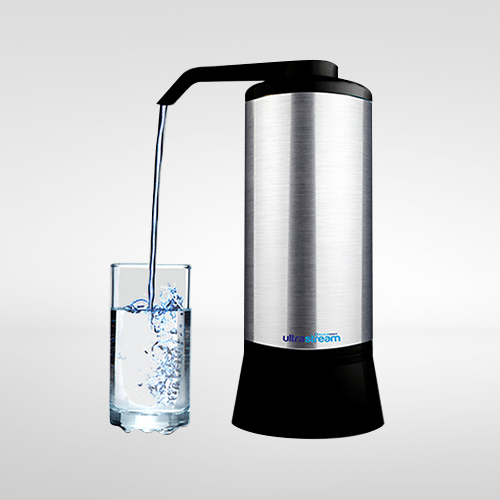
We all know that access to clean, freshwater is fundamental to our health and wellbeing, and filtering our water ensures that this is achieved. Most water filters remove harmful chemicals and bacteria, which if consumed can cause diseases and general ill-health. There are many other benefits of filtered water, including a better taste, and being more cost-effective and environmentally friendly when compared to buying bottled water.
Water Quality in Australia
Although the Australian government is required to provide us with safe drinking water, we are still at risk of temporary contaminants such as chemicals, heavy metals, pesticides, bacteria, and so on. A resident of an outback town recently found that the chlorine levels in her drinking water were consistent to those in her swimming pool – read the full story here. Chlorine is used in waterways to eliminate harmful micro-organisms, but this can be detrimental to our health when over-contamination and resulting consumption occurs. For this reason, along with many others, it’s important to filter your water.
What Some Water Filters don’t do…
While water filters remove the majority of contaminates, it’s important to be aware that different filters have different results. Some filters don’t stop all harmful bacteria and chemicals. If you are supplied by tank water and have a water filtration system and aren’t sure if you’re fully protected, the simplest and most effective way of ensuring that your water is safe and clean is by combining it with water disinfectant product. Our CleanOxide water sanitization tablets are great for use in water tanks – view here. We also provide testing kits to ensure your water is safe to drink, you can view these here.
UltraStream Water Filter & Hydrogen Rich Water Ionizer
The UltraStream is the world’s most advanced Water filter unit. It purifies, alkalizes, ionizes and infuses the water with molecular hydrogen. And… it’s extremely affordable!
If you don’t have a water filtration system currently installed in your home, we recommend using the new UltraStream Hydrogen Rich Water Ionizer. Simply put, it is a better, simpler, far more affordable way to alkalize, ionize and purify water. Benefits of this system include:
Contact us for more information.…
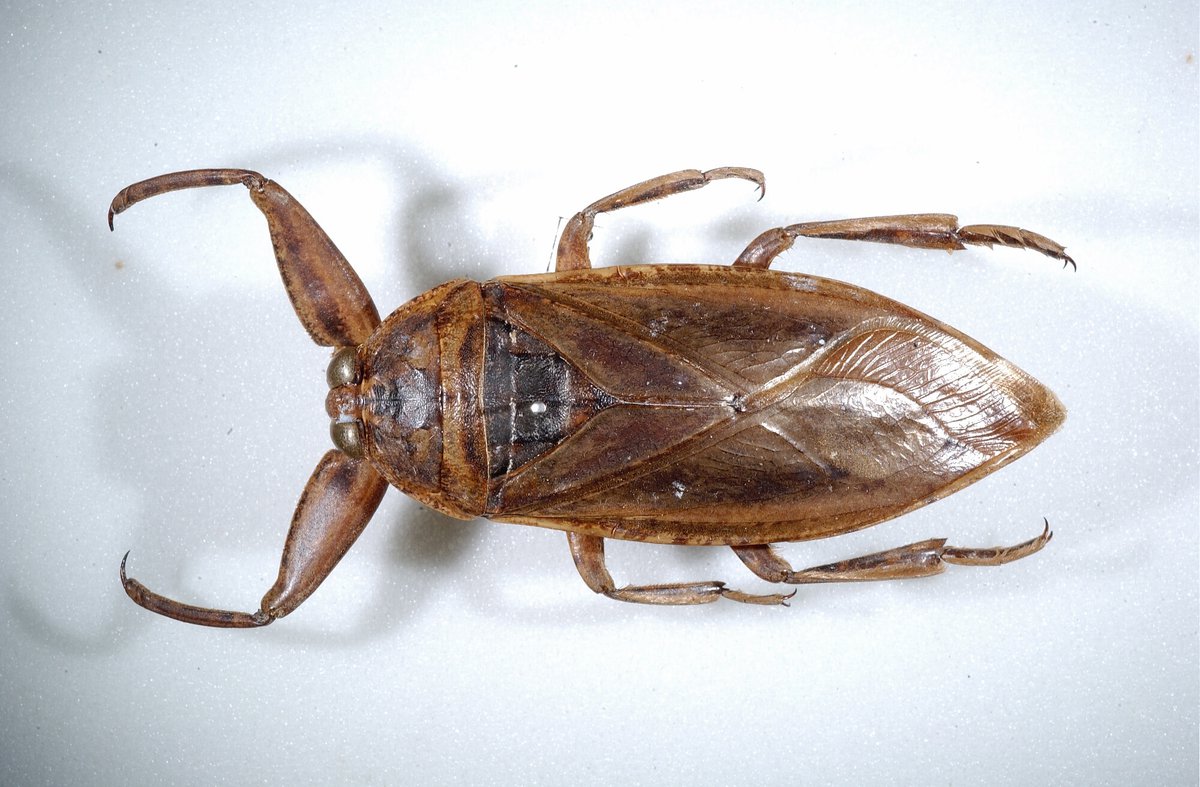
Although many people refer to various cockroach species as waterbugs, the true water bug is an aquatic insect classified under the order Hemiptera. Water boatmen and water scorpions are true bugs that live in water. Their legs are used as paddles to move through water. Members of the Gerridae family, such as water striders, pond skaters and water spiders, are also water bugs. However, instead of using their legs as paddles, they make use of surface tension to stay afloat.
One common example of an insect that is referred to as a waterbug is actually the oriental cockroach (Blatta orientalis). Contrary to its name, the oriental cockroach is native to Africa. Oriental cockroaches (water bugs) are shiny and black or dark brown in color. Nymphs of the species are smaller. Adult males are smaller than females. Oriental cockroaches do not have full-sized wings, and they are unable to fly.
In warm weather, oriental cockroaches can be found outside in trash cans and sewers. In colder seasons, they migrate inside seeking warmth. They are most commonly located in basements and other damp areas at or below ground level. Oriental cockroaches have seasonal development cycles, with adults emerging in warm seasons.
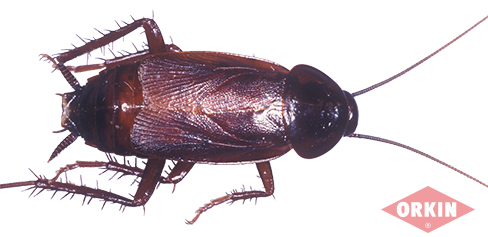
Like most other cockroaches, the oriental cockroach can eat many foods it happens upon. It is especially fond of starchy foods and decaying plant and animal matter. Given enough water, oriental cockroaches can survive up to one month without food. However, they cannot survive more than two weeks without water.
Cockroaches are adaptable insects. Although they gather in warm, moist areas, they are not aquatic like true waterbugs. Cockroaches are scavengers who consume any organic food source available to them. These insects normally are nocturnal and hide in crevices during the day. Cockroaches are capable of spreading human disease and triggering allergies and asthma. Oriental cockroaches can spread contaminants which can cause diarrhea and food poisoning. They are attracted to food sources indoors and require a science-based solution tailored to each home to best control them. In order to get rid of a cockroach infestation, contact your local pest control professional. Contact us for more information.…
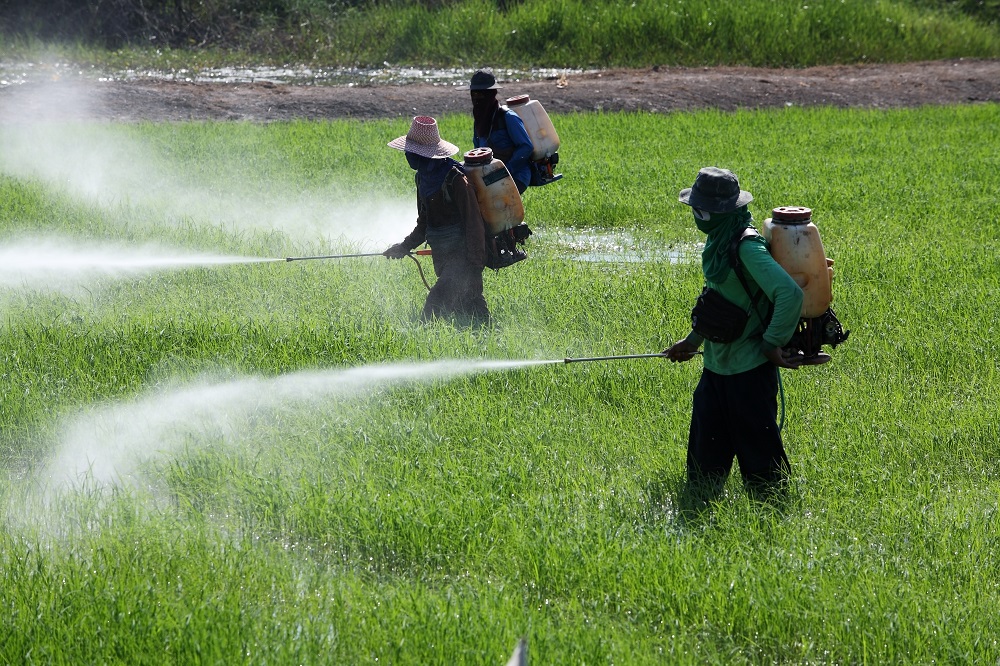
The term “pesticide” is a composite term that includes all chemicals that are used to kill or control pests. Pesticides are used to protect crops against insects, weeds, fungi, and other pests. They also play a significant role in food production. They protect or increase yields, and the number of times per year a crop can be grown on the same land. In agriculture, this includes herbicides (weeds), insecticides (insects), fungicides (fungi), nematocides (nematodes), and rodenticides (vertebrate poisons).

Drainage: Farmland is often well drained and natural drainage is often enhanced by land drains. Water from excessive rainfall and irrigation cannot always be held within the soil structure. Therefore, pesticides and residues (also nitrates and phosphates) can be quickly transported to contaminate ground water and freshwater supplies over a large geographical area.
The pesticide: Individual pesticides have unique properties, and many variable factors (including those below) determine the specific risk in terms of water pollution.
An active substance is any chemical, plant extract, pheromone, or microorganism (including viruses), that has action against ‘pests’ or on plants, or parts of plants or plant products.
Mobility in soil: All pesticides have unique mobility properties, both vertically and horizontally through the soil structure. Residual herbicides applied directly to the soil are designed to bond to the soil structure.
Solubility in water: Many pesticides are soluble in water out of necessity so that they can be applied with water and be absorbed by the target. The higher the solubility of the pesticide, the higher the risk of leaching. Residual herbicides are generally of lower solubility to aid soil binding but their persistency in the soil can cause other problems.
Microbial activity: Pesticides in the soil are primarily broken down by microbial activity. The greater the microbial activity, the faster the degradation. Loss of pesticide residues can also occur by evaporation and photodecomposition.
Soil temperature: Soil microbial activity and pesticide breakdown is largely linked to soil temperature.
Application rate: The more pesticide that is applied, the longer significant concentrations remain.
Irrigation Management: Irrigation increases the chance that pesticides will migrate to ground water and surface water. Irrigating saturated soils or irrigating at a rate that exceeds the infiltration rate of soil promotes runoff that can carry pesticides with it. Irrigation that promotes the frequent downward movement of water beyond the root zone of plants also promotes the leaching of substances including pesticides to ground water. This is of particular concern in areas where frequent irrigation is necessary because of coarse-textured soils. Proper irrigation management is critical to minimize the risk of pesticides infiltrating ground water.

Another factor affecting pesticide pollution of water is rainfall, as high levels of rainfall increase the risk of pesticides contaminating water. Movement into bodies of water occurs when runoff, after rainfall, moves through areas that have been sprayed with pesticides. It can also occur within the soil structure by displacement of pesticides from absorption sites near water and through treated soil that has moved into the water through soil erosion.
The Cornell University Cooperative Extension states “cleanup of groundwater contaminated by pesticides is usually impossible. The slow movement of groundwater means that it may take decades for the contaminated water to flow beyond the affected wells. Determining which wells will be affected and for how long is a difficult problem.”
They also observed the problem with private wells and state that “most family farms rely on their own wells and private wells are rarely tested or treated and in many instances are located close to fields on which pesticides have been applied. While not all wells can become contaminated, it is important to know why some become contaminated (leached) and why others do not.”
The Cornell University states:
Leaching of pesticides depends in part on the amount applied per acre per year; where, when and how it is applied; the solubility of the compound: how strongly it is held by the soil; and how quickly it breaks down in the root zone. After a pesticide is applied to a field, it meets a variety of fates. Some may be lost to the atmosphere through volatilization, carried away to surface waters by runoff, or broken down in the sunlight by photolysis. Pesticides in soil may be taken up by plants, degraded into other chemical forms, or leached downward, possibly to groundwater. The remainder is retained in the soil and continues to be available for plant uptake, degradation or leaching.
How much pesticide meets each of these fates depends on many factors including:
Many pesticides bind strongly to soil and are, therefore, immobile. For those that are mobile in soil, their leaching to ground water can be thought of as a race in time between their degradation into nontoxic by-products and their transport to ground water. If the pesticide is not readily degraded and moved freely with water percolating downward through the soil, the likelihood of it reaching ground water is relatively high. If, however, the pesticide degrades quickly or is tightly bound to soil particles, then it is more likely to be retained in the upper soil layers until it is degraded to nontoxic by-products.
In the U.S., about 10% of the country’s population (approximately 13 million people) rely on water from private wells but the private wells are not regulated under the Safe Drinking Water Act (SDWA). The SDWA does not provide recommended criteria or standards for individual wells, but it does provide information about technologies that may be used to treat or remove any contaminants. It also educates well owners on ground water and provides them with information that is useful to them in protecting their health.
The health effects of pesticides depend on the type of pesticide. Some, such as the organophosphates and carbamates, affect the nervous …
The term “pesticide” is a composite term that includes all chemicals that are used to kill or control pests. Pesticides are used to protect crops against insects, weeds, fungi, and other pests. They also play a significant role in food production. They protect or increase yields, and the number of times per year a crop can be grown on the same land. In agriculture, this includes herbicides (weeds), insecticides (insects), fungicides (fungi), nematocides (nematodes), and rodenticides (vertebrate poisons).
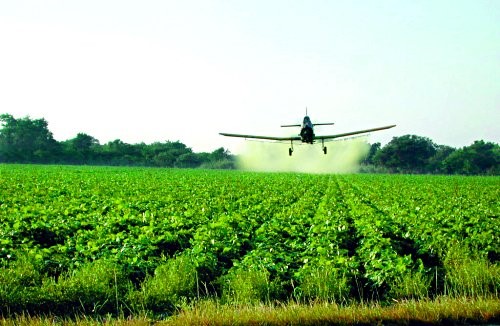
Drainage: Farmland is often well drained and natural drainage is often enhanced by land drains. Water from excessive rainfall and irrigation cannot always be held within the soil structure. Therefore, pesticides and residues (also nitrates and phosphates) can be quickly transported to contaminate ground water and freshwater supplies over a large geographical area.
The pesticide: Individual pesticides have unique properties, and many variable factors (including those below) determine the specific risk in terms of water pollution.
An active substance is any chemical, plant extract, pheromone, or microorganism (including viruses), that has action against ‘pests’ or on plants, or parts of plants or plant products.
Mobility in soil: All pesticides have unique mobility properties, both vertically and horizontally through the soil structure. Residual herbicides applied directly to the soil are designed to bond to the soil structure.
Solubility in water: Many pesticides are soluble in water out of necessity so that they can be applied with water and be absorbed by the target. The higher the solubility of the pesticide, the higher the risk of leaching. Residual herbicides are generally of lower solubility to aid soil binding but their persistency in the soil can cause other problems.
Microbial activity: Pesticides in the soil are primarily broken down by microbial activity. The greater the microbial activity, the faster the degradation. Loss of pesticide residues can also occur by evaporation and photodecomposition.
Soil temperature: Soil microbial activity and pesticide breakdown is largely linked to soil temperature.
Application rate: The more pesticide that is applied, the longer significant concentrations remain.
Irrigation Management: Irrigation increases the chance that pesticides will migrate to ground water and surface water. Irrigating saturated soils or irrigating at a rate that exceeds the infiltration rate of soil promotes runoff that can carry pesticides with it. Irrigation that promotes the frequent downward movement of water beyond the root zone of plants also promotes the leaching of substances including pesticides to ground water. This is of particular concern in areas where frequent irrigation is necessary because of coarse-textured soils. Proper irrigation management is critical to minimize the risk of pesticides infiltrating ground water.
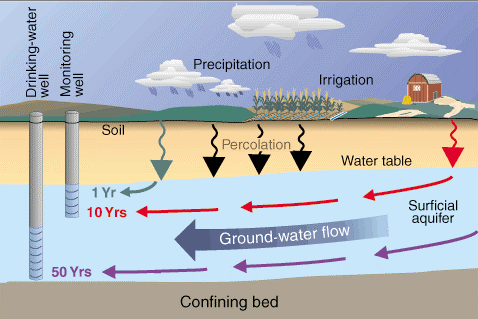
Another factor affecting pesticide pollution of water is rainfall, as high levels of rainfall increase the risk of pesticides contaminating water. Movement into bodies of water occurs when runoff, after rainfall, moves through areas that have been sprayed with pesticides. It can also occur within the soil structure by displacement of pesticides from absorption sites near water and through treated soil that has moved into the water through soil erosion.
The Cornell University Cooperative Extension states “cleanup of groundwater contaminated by pesticides is usually impossible. The slow movement of groundwater means that it may take decades for the contaminated water to flow beyond the affected wells. Determining which wells will be affected and for how long is a difficult problem.”
They also observed the problem with private wells and state that “most family farms rely on their own wells and private wells are rarely tested or treated and in many instances are located close to fields on which pesticides have been applied. While not all wells can become contaminated, it is important to know why some become contaminated (leached) and why others do not.”
The Cornell University states:
Leaching of pesticides depends in part on the amount applied per acre per year; where, when and how it is applied; the solubility of the compound: how strongly it is held by the soil; and how quickly it breaks down in the root zone. After a pesticide is applied to a field, it meets a variety of fates. Some may be lost to the atmosphere through volatilization, carried away to surface waters by runoff, or broken down in the sunlight by photolysis. Pesticides in soil may be taken up by plants, degraded into other chemical forms, or leached downward, possibly to groundwater. The remainder is retained in the soil and continues to be available for plant uptake, degradation or leaching.
How much pesticide meets each of these fates depends on many factors including:
Many pesticides bind strongly to soil and are, therefore, immobile. For those that are mobile in soil, their leaching to ground water can be thought of as a race in time between their degradation into nontoxic by-products and their transport to ground water. If the pesticide is not readily degraded and moved freely with water percolating downward through the soil, the likelihood of it reaching ground water is relatively high. If, however, the pesticide degrades quickly or is tightly bound to soil particles, then it is more likely to be retained in the upper soil layers until it is degraded to nontoxic by-products.
In the U.S., about 10% of the country’s population (approximately 13 million people) rely on water from private wells but the private wells are not regulated under the Safe Drinking Water Act (SDWA). The SDWA does not provide recommended criteria or standards for individual wells, but it does provide information about technologies that may be used to treat or remove any contaminants. It also educates well owners on ground water and provides them with information that is useful to them in protecting their health.
The health effects of pesticides depend on the type of pesticide. Some, such as the organophosphates and …
Lorem ipsum dolor sit amet, consectetur adipiscing elit. Praesent eros lacus, accumsan sit amet iaculis et, varius ac metus. Cras imperdiet porttitor lacus eu lobortis. Aliquam vel metus at felis tincidunt ultrices et ac nulla. Nam non consectetur ligula, id mattis elit. Quisque eget massa ipsum. Nam vitae blandit quam. Quisque auctor tincidunt dui quis tempor. Sed rutrum purus nec fermentum pretium. Nam sem est, congue vitae ante vitae, viverra consequat turpis. Sed finibus quam leo, et dictum nibh mollis ac. Suspendisse consectetur, lectus sollicitudin elementum finibus, diam risus porta arcu, quis sodales risus massa quis erat.
Etiam lacus risus, blandit quis quam ut, dictum pellentesque sapien. Maecenas lobortis elit eu mi cursus egestas. Quisque faucibus nisi sit amet sapien lobortis vehicula ut et velit. Praesent sit amet urna et dui fringilla pharetra ac sed mi. Nulla mauris tellus, scelerisque ac sodales in, finibus in felis. Integer rhoncus mauris lorem. Donec eget nunc libero. Sed neque nisi, hendrerit vitae enim vel, eleifend porta nulla. Nullam pulvinar nibh quis viverra consectetur. Etiam molestie accumsan libero, quis laoreet odio lobortis dictum. Aliquam nec lacus ligula. Suspendisse vestibulum sagittis dui, et laoreet odio aliquam id. Proin in nibh at turpis placerat porta. Donec imperdiet fringilla nisi, non gravida velit porta quis.
Maecenas quis ipsum pretium, congue libero ac, blandit odio. Sed id erat ac nunc tristique interdum congue vitae nisl. Ut sit amet libero nec dolor euismod pharetra. Nam varius metus vitae finibus euismod. Nulla facilisi. Ut lacinia, ipsum a venenatis fringilla, ex ex bibendum urna, non molestie quam purus eu lacus. Nunc ac felis gravida, posuere nibh sit amet, facilisis ipsum. Sed augue justo, pharetra vitae libero eget, ullamcorper fringilla augue. Aenean eu rutrum ligula, in feugiat ligula. Pellentesque non pharetra quam, vitae posuere nibh. Integer non nunc congue, dictum mauris vel, sollicitudin risus. Nunc rutrum leo in turpis tincidunt commodo. Pellentesque habitant morbi tristique senectus et netus et malesuada fames ac turpis egestas. Aenean pretium efficitur dolor.
Vestibulum suscipit erat lorem, in interdum lectus lacinia ut. Nulla facilisi. Donec vehicula lacus a turpis tristique, elementum tempus tortor iaculis. Nulla consectetur erat est, nec sagittis dui suscipit non. Aenean non maximus dui. Maecenas ac finibus arcu. Fusce eleifend lectus mi, feugiat tincidunt mi pharetra in. Donec vitae ultricies neque, id pharetra nisi. Lorem ipsum dolor sit amet, consectetur adipiscing elit. Pellentesque viverra nulla mi, sit amet congue urna mollis ac. Vestibulum tristique vehicula sem, sed dictum justo pharetra id. Vestibulum nec varius mi. Donec eget metus vitae diam molestie elementum ac eu massa. Aenean pretium viverra hendrerit. Nam metus magna, commodo vel lorem id, iaculis porttitor nisl. Orci varius natoque penatibus et magnis dis parturient montes, nascetur ridiculus mus.
Suspendisse quis erat ipsum. Ut aliquet ultrices iaculis. Etiam malesuada fringilla magna, non sodales diam iaculis non. Pellentesque habitant morbi tristique senectus et netus et malesuada fames ac turpis egestas. Maecenas non orci ipsum. Quisque ac mauris est. Quisque porta mauris ligula, et egestas purus dignissim sed. Nunc accumsan non enim a imperdiet.…
Lorem ipsum dolor sit amet, consectetur adipiscing elit. Praesent eros lacus, accumsan sit amet iaculis et, varius ac metus. Cras imperdiet porttitor lacus eu lobortis. Aliquam vel metus at felis tincidunt ultrices et ac nulla. Nam non consectetur ligula, id mattis elit. Quisque eget massa ipsum. Nam vitae blandit quam. Quisque auctor tincidunt dui quis tempor. Sed rutrum purus nec fermentum pretium. Nam sem est, congue vitae ante vitae, viverra consequat turpis. Sed finibus quam leo, et dictum nibh mollis ac. Suspendisse consectetur, lectus sollicitudin elementum finibus, diam risus porta arcu, quis sodales risus massa quis erat.
Etiam lacus risus, blandit quis quam ut, dictum pellentesque sapien. Maecenas lobortis elit eu mi cursus egestas. Quisque faucibus nisi sit amet sapien lobortis vehicula ut et velit. Praesent sit amet urna et dui fringilla pharetra ac sed mi. Nulla mauris tellus, scelerisque ac sodales in, finibus in felis. Integer rhoncus mauris lorem. Donec eget nunc libero. Sed neque nisi, hendrerit vitae enim vel, eleifend porta nulla. Nullam pulvinar nibh quis viverra consectetur. Etiam molestie accumsan libero, quis laoreet odio lobortis dictum. Aliquam nec lacus ligula. Suspendisse vestibulum sagittis dui, et laoreet odio aliquam id. Proin in nibh at turpis placerat porta. Donec imperdiet fringilla nisi, non gravida velit porta quis.
Maecenas quis ipsum pretium, congue libero ac, blandit odio. Sed id erat ac nunc tristique interdum congue vitae nisl. Ut sit amet libero nec dolor euismod pharetra. Nam varius metus vitae finibus euismod. Nulla facilisi. Ut lacinia, ipsum a venenatis fringilla, ex ex bibendum urna, non molestie quam purus eu lacus. Nunc ac felis gravida, posuere nibh sit amet, facilisis ipsum. Sed augue justo, pharetra vitae libero eget, ullamcorper fringilla augue. Aenean eu rutrum ligula, in feugiat ligula. Pellentesque non pharetra quam, vitae posuere nibh. Integer non nunc congue, dictum mauris vel, sollicitudin risus. Nunc rutrum leo in turpis tincidunt commodo. Pellentesque habitant morbi tristique senectus et netus et malesuada fames ac turpis egestas. Aenean pretium efficitur dolor.
Vestibulum suscipit erat lorem, in interdum lectus lacinia ut. Nulla facilisi. Donec vehicula lacus a turpis tristique, elementum tempus tortor iaculis. Nulla consectetur erat est, nec sagittis dui suscipit non. Aenean non maximus dui. Maecenas ac finibus arcu. Fusce eleifend lectus mi, feugiat tincidunt mi pharetra in. Donec vitae ultricies neque, id pharetra nisi. Lorem ipsum dolor sit amet, consectetur adipiscing elit. Pellentesque viverra nulla mi, sit amet congue urna mollis ac. Vestibulum tristique vehicula sem, sed dictum justo pharetra id. Vestibulum nec varius mi. Donec eget metus vitae diam molestie elementum ac eu massa. Aenean pretium viverra hendrerit. Nam metus magna, commodo vel lorem id, iaculis porttitor nisl. Orci varius natoque penatibus et magnis dis parturient montes, nascetur ridiculus mus.
Suspendisse quis erat ipsum. Ut aliquet ultrices iaculis. Etiam malesuada fringilla magna, non sodales diam iaculis non. Pellentesque habitant morbi tristique senectus et netus et malesuada fames ac turpis egestas. Maecenas non orci ipsum. Quisque ac mauris est. Quisque porta mauris ligula, et egestas purus dignissim sed. Nunc accumsan non enim a imperdiet.…
Lorem ipsum dolor sit amet, consectetur adipiscing elit. Praesent eros lacus, accumsan sit amet iaculis et, varius ac metus. Cras imperdiet porttitor lacus eu lobortis. Aliquam vel metus at felis tincidunt ultrices et ac nulla. Nam non consectetur ligula, id mattis elit. Quisque eget massa ipsum. Nam vitae blandit quam. Quisque auctor tincidunt dui quis tempor. Sed rutrum purus nec fermentum pretium. Nam sem est, congue vitae ante vitae, viverra consequat turpis. Sed finibus quam leo, et dictum nibh mollis ac. Suspendisse consectetur, lectus sollicitudin elementum finibus, diam risus porta arcu, quis sodales risus massa quis erat.
Etiam lacus risus, blandit quis quam ut, dictum pellentesque sapien. Maecenas lobortis elit eu mi cursus egestas. Quisque faucibus nisi sit amet sapien lobortis vehicula ut et velit. Praesent sit amet urna et dui fringilla pharetra ac sed mi. Nulla mauris tellus, scelerisque ac sodales in, finibus in felis. Integer rhoncus mauris lorem. Donec eget nunc libero. Sed neque nisi, hendrerit vitae enim vel, eleifend porta nulla. Nullam pulvinar nibh quis viverra consectetur. Etiam molestie accumsan libero, quis laoreet odio lobortis dictum. Aliquam nec lacus ligula. Suspendisse vestibulum sagittis dui, et laoreet odio aliquam id. Proin in nibh at turpis placerat porta. Donec imperdiet fringilla nisi, non gravida velit porta quis.
Maecenas quis ipsum pretium, congue libero ac, blandit odio. Sed id erat ac nunc tristique interdum congue vitae nisl. Ut sit amet libero nec dolor euismod pharetra. Nam varius metus vitae finibus euismod. Nulla facilisi. Ut lacinia, ipsum a venenatis fringilla, ex ex bibendum urna, non molestie quam purus eu lacus. Nunc ac felis gravida, posuere nibh sit amet, facilisis ipsum. Sed augue justo, pharetra vitae libero eget, ullamcorper fringilla augue. Aenean eu rutrum ligula, in feugiat ligula. Pellentesque non pharetra quam, vitae posuere nibh. Integer non nunc congue, dictum mauris vel, sollicitudin risus. Nunc rutrum leo in turpis tincidunt commodo. Pellentesque habitant morbi tristique senectus et netus et malesuada fames ac turpis egestas. Aenean pretium efficitur dolor.
Vestibulum suscipit erat lorem, in interdum lectus lacinia ut. Nulla facilisi. Donec vehicula lacus a turpis tristique, elementum tempus tortor iaculis. Nulla consectetur erat est, nec sagittis dui suscipit non. Aenean non maximus dui. Maecenas ac finibus arcu. Fusce eleifend lectus mi, feugiat tincidunt mi pharetra in. Donec vitae ultricies neque, id pharetra nisi. Lorem ipsum dolor sit amet, consectetur adipiscing elit. Pellentesque viverra nulla mi, sit amet congue urna mollis ac. Vestibulum tristique vehicula sem, sed dictum justo pharetra id. Vestibulum nec varius mi. Donec eget metus vitae diam molestie elementum ac eu massa. Aenean pretium viverra hendrerit. Nam metus magna, commodo vel lorem id, iaculis porttitor nisl. Orci varius natoque penatibus et magnis dis parturient montes, nascetur ridiculus mus.
Suspendisse quis erat ipsum. Ut aliquet ultrices iaculis. Etiam malesuada fringilla magna, non sodales diam iaculis non. Pellentesque habitant morbi tristique senectus et netus et malesuada fames ac turpis egestas. Maecenas non orci ipsum. Quisque ac mauris est. Quisque porta mauris ligula, et egestas purus dignissim sed. Nunc accumsan non enim a imperdiet.…
Are you suffering a lot due to pest issues in your house or office premises? It is common for all of us to suffer a lot due to the pest issues in our place. Do you know the meaning of pest? Any animal or plant that causes severe damage or harm humans is called a pest. The pest is the major disturbance to people by affecting their health and property to a greater extent. The major pests are ants, cockroaches, mosquitoes, rats, flies, fleas, wasps, bedbugs, rodents, etc. The pest problem is a devastating issue for all humans from across the globe. The pest causes continuous trouble and also severe money loss to an individual
Pest controlling is not an easy task by an individual, but it is a daunting task to all Yes, controlling pests at the premises of an individual or office need a technical expert who deals with pests. Hence, it is of utmost importance to contact a pest control company like P…